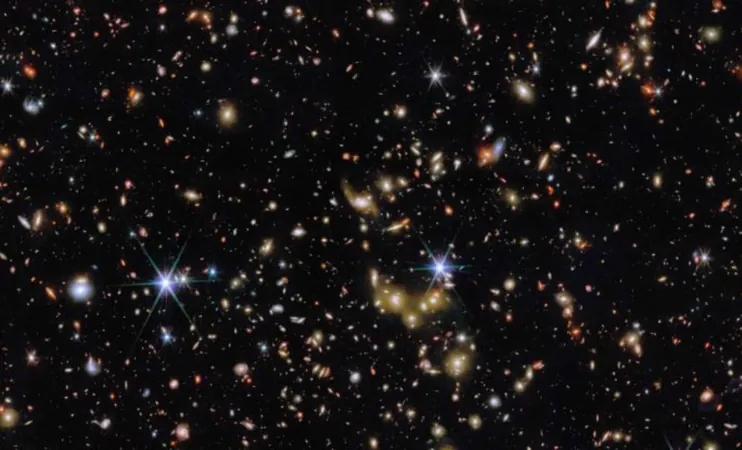
Astounding Discovery: Each Flicker of Light Is a Distant Galaxy!
2025-05-08
Author: Ying
NASA's Groundbreaking Image of the Cosmos
NASA’s James Webb Space Telescope (JWST) has unveiled a breathtaking deep-field image showcasing a minuscule portion of the sky, revealing that nearly every twinkling point of light represents a galaxy.
A Glimpse into 12 Billion Years of Cosmic History
This stunning snapshot, featured in a recent Astronomy & Astrophysics study, highlights galaxies that date back nearly 12 billion light-years. It’s a part of the transformative COSMOS-Web survey, changing our understanding of the universe.
Unveiling a Universe Bursting with Galaxies
Unlike ordinary night sky views that primarily show stars, this JWST image bursts with galaxies that have existed for eons. Each galaxy is a colossal collection of stars, dust, and dark matter, some nearly as old as time itself!
The Astonishing Detail in a Tiny Patch of Sky
What’s truly captivating about this image is the detailed information packed into a seemingly trivial area of sky—less than one-fifth the size of the Moon. In this minuscule space, thousands of galaxies come to life!
JWST's Unique Precision—Stars or Galaxies?
One of JWST’s remarkable features is its ability to differentiate between foreground stars and far-off galaxies. The telescope reveals distinctive diffraction spikes in star light, while galaxies shine with a softer glow, allowing astronomers to gather accurate data.
A Cosmic Light Journey of 6.5 Billion Years
At the focal point of the image shines a cluster of galaxies, their light having traveled 6.5 billion years to reach us. This snapshot not only illuminates these celestial bodies but also places the universe’s incredible age into perspective.
COSMOS-Web Survey: Mapping the Cosmic Tapestry
The COSMOS-Web survey plays a pivotal role in this astonishing revelation. It aims to catalog galaxy groups, helping researchers unlock the mysteries of galaxy evolution and the cosmic web that binds them.
The Cosmic Clusters—A New Era of Discovery
JWST's cutting-edge observations have unveiled massive galaxy clusters, and by merging its data with X-ray insights from the Chandra X-ray Observatory, astronomers have identified some of the largest clusters ever recorded.
1,678 Galaxy Groups: A Breath of the Cosmic Scale
An international team of astronomers, led by Greta Toni from the University of Bologna, has cataloged 1,678 galaxy groups based on the latest JWST findings. This catalog provides a staggering glimpse into the complex architecture of the cosmos.
Reflecting on Our Place in the Universe
One of the most profound insights from this image is the sheer enormity of the universe. The photographed region is merely 6.44 by 6.44 arcminutes yet brims with over a thousand galaxy groups. To put it in perspective, the full Moon spans roughly 30 arcminutes—illustrating just how dense and alive this tiny area of the night sky truly is!


 Brasil (PT)
Brasil (PT)
 Canada (EN)
Canada (EN)
 Chile (ES)
Chile (ES)
 Česko (CS)
Česko (CS)
 대한민국 (KO)
대한민국 (KO)
 España (ES)
España (ES)
 France (FR)
France (FR)
 Hong Kong (EN)
Hong Kong (EN)
 Italia (IT)
Italia (IT)
 日本 (JA)
日本 (JA)
 Magyarország (HU)
Magyarország (HU)
 Norge (NO)
Norge (NO)
 Polska (PL)
Polska (PL)
 Schweiz (DE)
Schweiz (DE)
 Singapore (EN)
Singapore (EN)
 Sverige (SV)
Sverige (SV)
 Suomi (FI)
Suomi (FI)
 Türkiye (TR)
Türkiye (TR)
 الإمارات العربية المتحدة (AR)
الإمارات العربية المتحدة (AR)